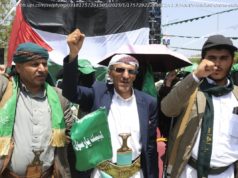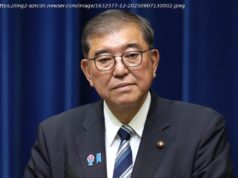An estimated 4,645 people died in Hurricane Maria and its aftermath in Puerto Rico, according to an academic report published Tuesday in a prestigious medical journal. That figure dwarfs Puerto Rico’s official death toll of 64, which the article’s authors called a « substantial underestimate » of Hurricane Maria’s death toll.
Previous estimates suggested Maria contributed to about 1,000 deaths.
The team from Harvard arrived at its much-higher estimate by surveying 3,299 randomly chosen households across the island earlier this year. Authors compared results of that survey — which asked island residents about deaths in their homes, among other things — with official mortality statistics from 2016. That allowed researchers to estimate the number of deaths that likely occurred as a result of Hurricane Maria between the date of the storm and December 31,2017.
« The difference is that we went out and we had boots on the ground and we did the interviews, » said Domingo Marqués, an associate professor of clinical psychology at Carlos Albizu University in Puerto Rico, who was among the report’s authors.
« Statistically, it’s like having interviewed the whole island, » he said.
Still, the exact death toll is likely to remain a mystery. Experts tell CNN it is difficult to say with certainty whether a hurricane « caused » certain deaths, especially those that occurred because of the chaotic and unsafe conditions that have lingered for months in Puerto Rico. Marqués and colleagues say 793 to 8,498 hurricane deaths occurred.
In a news conference on Tuesday, Hector Pesquera, head of Puerto Rico’s public safety department, said the government did not have reason to question the latest estimates, which come from researchers at Harvard University as well as Beth Israel Deaconess Medical Center, the University of Colorado and universities in Puerto Rico.
US territory officials stressed that the Puerto Rican government has hired George Washington University to conduct an assessment of Maria’s death toll and that the results of that review are still forthcoming. Previously, officials had expected the George Washington University report to be released this spring, before the Atlantic hurricane season, which begins on June 1.
« The Government of Puerto Rico welcomes the newly released Harvard University survey and we look forward to analyzing it, » Carlos R. Mercader, executive director of the Puerto Rico Federal Affairs Administration, said in a press release.
« As the world knows, the magnitude of this tragic disaster caused by Hurricane Maria resulted in many fatalities. We have always expected the number to be higher than what was previously reported. That is why we commissioned The George Washington University to carry out a thorough study on the number of fatalities caused by Hurricane Maria which will be released soon. Both studies will help us better prepare for future natural disasters and prevent lives from being lost. »
The Harvard study says the Puerto Rican and US governments did not provide adequate services — including electrical power and medical assistance — after the hurricane. It also notes that Puerto Rican officials have refused to make public basic mortality statistics.
The US Federal Emergency Management Agency (FEMA), which oversees disaster recovery, has said it encountered unique logistical challenges on the island after the storm that make comparisons between the response to Maria and other storms problematic.
CNN and the Center for Investigative Journalism (CPI) in Puerto Rico are suing the island’s demographic registry for access to death records that have been withheld.
In November, CNN surveyed 112 funeral homes — about half the total — across Puerto Rico, in a moment when many communication systems remained inoperable. At that time, funeral home directors identified 499 deaths they considered to be hurricane-related.
Puerto Rico added at least two people to its official count following CNN’s investigation.
One was Quintín Vidal Rolón, 89, who died in a lantern fire that relatives said occurred because of the storm; Vidal was using the lantern because he didn’t have electricity.
Other uncounted deaths occurred in environments where people lacked electricity or other basic services, including communications. Many roads were blocked after the storm. And hurricane-related deaths appear to have continued for months after the September hurricane.
Natalio Rodriguez Lebron, 77, for example, died in Maunabo, Puerto Rico, in January. His family says that’s because they couldn’t afford to power a breathing machine that helped keep him alive.
While most power and water service has been restored, thousands of people here remain without electricity — more than eight months after Hurricane Maria.
The latest death-toll estimate could be seen as an indictment of the federal response to the storm, said Dr. Gregory J. Davis, director of the University of Kentucky’s Forensic Pathology Consultation Service.
« This alone should make your readers and the readers of the New England Journal really stand up and take notice — and frankly be asking our government ‘Why?’ » he said. « Our government is not doing what they should be doing down there. It’s infuriating, that’s the bottom line. »
The New England Journal of Medicine article adds to « a growing consensus that deaths have been undercounted by the Puerto Rican government, » said Alexis Santos, a demographer at Penn State University who also has researched the death toll following Maria.
« This is a valid way of looking at it, » he said of the research from Harvard. Still, « The way this is done, by interviews with people in different barrios in Puerto Rico, it seems to me that someone could report a death as associated with the hurricane when it was not. »
That could result in an overcounting of deaths, he said.
The Harvard team, meanwhile, says that, if anything, its estimates are low. It would be impossible to identify some deaths using a survey, Marqués said. For example, if a person died while living alone there would be no person in that home able to answer questions.






